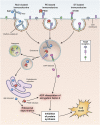Immunotoxins for leukemia
- PMID: 24578503
- PMCID: PMC3990911
- DOI: 10.1182/blood-2014-01-492256
Immunotoxins for leukemia
Abstract
Unconjugated monoclonal antibodies that target hematopoietic differentiation antigens have been developed to treat hematologic malignancies. Although some of these have activity against chronic lymphocytic leukemia and hairy cell leukemia, in general, monoclonal antibodies have limited efficacy as single agents in the treatment of leukemia. To increase their potency, the binding domains of monoclonal antibodies can be attached to protein toxins. Such compounds, termed immunotoxins, are delivered to the interior of leukemia cells based on antibody specificity for cell surface target antigens. Recombinant immunotoxins have been shown to be highly cytotoxic to leukemic blasts in vitro, in xenograft model systems, and in early-phase clinical trials in humans. These agents will likely play an increasing role in the treatment of leukemia.
Figures


Similar articles
-
Treatment of hematologic malignancies with immunotoxins and antibody-drug conjugates.Cancer Res. 2011 Oct 15;71(20):6300-9. doi: 10.1158/0008-5472.CAN-11-1374. Cancer Res. 2011. PMID: 21998010 Free PMC article. Review.
-
Monoclonal antibodies in the treatment of chronic lymphoid leukemias.Leuk Lymphoma. 2004 Feb;45(2):205-19. doi: 10.1080/1042819031000139666. Leuk Lymphoma. 2004. PMID: 15101704 Review.
-
Phase I study of a bispecific ligand-directed toxin targeting CD22 and CD19 (DT2219) for refractory B-cell malignancies.Clin Cancer Res. 2015 Mar 15;21(6):1267-72. doi: 10.1158/1078-0432.CCR-14-2877. Clin Cancer Res. 2015. PMID: 25770294 Free PMC article. Clinical Trial.
-
Immunotoxins in cancer therapy: Review and update.Int Rev Immunol. 2017 Jul 4;36(4):207-219. doi: 10.1080/08830185.2017.1284211. Epub 2017 Mar 1. Int Rev Immunol. 2017. PMID: 28282218 Review.
-
Recombinant immunotoxins for treating cancer.Int J Med Microbiol. 2004 Apr;293(7-8):577-82. doi: 10.1078/1438-4221-00302. Int J Med Microbiol. 2004. PMID: 15149034 Review.
Cited by
-
Plant-Derived Type I Ribosome Inactivating Protein-Based Targeted Toxins: A Review of the Clinical Experience.Toxins (Basel). 2022 Aug 18;14(8):563. doi: 10.3390/toxins14080563. Toxins (Basel). 2022. PMID: 36006226 Free PMC article. Review.
-
Phase 1 study of the anti-CD22 immunotoxin moxetumomab pasudotox for childhood acute lymphoblastic leukemia.Blood. 2017 Oct 5;130(14):1620-1627. doi: 10.1182/blood-2017-02-749101. Epub 2017 Aug 9. Blood. 2017. PMID: 28983018 Free PMC article. Clinical Trial.
-
Immunotoxins Immunotherapy against Hepatocellular Carcinoma: A Promising Prospect.Toxins (Basel). 2021 Oct 11;13(10):719. doi: 10.3390/toxins13100719. Toxins (Basel). 2021. PMID: 34679012 Free PMC article. Review.
-
A deimmunised form of the ribotoxin, α-sarcin, lacking CD4+ T cell epitopes and its use as an immunotoxin warhead.Protein Eng Des Sel. 2016 Nov 1;29(11):531-540. doi: 10.1093/protein/gzw045. Protein Eng Des Sel. 2016. PMID: 27578884 Free PMC article.
-
Reduced cytotoxicity by mutation of lysine 590 of Pseudomonas exotoxin can be restored in an optimized, lysine-free immunotoxin.Immunother Adv. 2022 Feb 21;2(1):ltac007. doi: 10.1093/immadv/ltac007. eCollection 2022. Immunother Adv. 2022. PMID: 35919491 Free PMC article.
References
Publication types
MeSH terms
Substances
Grants and funding
LinkOut - more resources
Full Text Sources
Other Literature Sources
Medical

